

|
Keith Meggs: A Man and his MachinesSgt. K.R. MeggsDFM., AAM. 77 Squadron RAAF, Kimpo, Korea Photographer: N/S, courtesy of Keith Meggs
The MachinesCAC-built, North American Mustang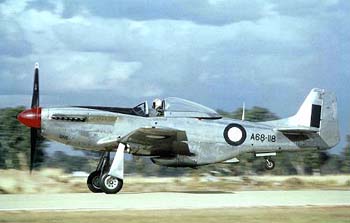 CA-18 Mustang (A68-118) also available as a 1225x761 pixel image
One of the finest American fighter aircraft of World War II, the North American Mustang owed its origin to a RAF specification for a single-seat fighter to replace the Curtiss P-40s. The first flight of the prototype NA-73 occurred in October 40. Production models reached the RAF in November 41 and these aircraft became known as Mustang Mk I (P-51) and Mk II (P-51A). The original 1,150 hp Allison engine lacked performance at high altitude, and the RAF employed the early Mustangs on low-level armed tactical reconnaissance sorties. Meantime, the USAAF ordered a limited number of P-51s and P-51As as the Apache, a tentative name which was later cancelled. The aircraft's potential appeared promising and RAF Mustangs Mk III (P-51B, P-51C and F-6) and Mk IV (P-51D) was the most widely produced version and 8,956 were built. Interesting developments of the Mustang included the XP-51F and XP-51G lightweight versions and, the fastest Mustang of all, the P-51 H with a top speed of 487 mph at 25,000 ft. The ultimate development occurred, post-war, when two Mustang fuselages were joined resulting in the USAAF F-82 Twin Mustang. Keith Meggs comments: This was in fact a new design with a close relationship to the P-51 H
USAF Museum - North American F-82/XP-82/P-82 "Twin" Mustang also... Read more about the F-82 Twin Mustang
In 1943, the Australian Government arranged for the Commonwealth Aircraft Corporation (CAC) to manufacture the Mustang Mk IV (P-51D) under licence from North American Aviation. The RAAF urgently needed a new fighter, and so the first CAC Mustangs were built mainly from imported semi-finished parts. A prototype Mustang, A68-1001 was used for development trials and the first Australian production Mustang, A68-1, flew on 29 April 45. This aircraft was handed over to the RAAF on 4 June 45 and was used for trials by No 1 APU until October 46. It was placed in storage until 1953 when it was delivered to the Department of Supply at Woomera. The first 80 Mustang 20s (A68-1/80) were delivered with Packard Merlin V-1650-3 engines, under the CA-17 designation. A second contract called for 170 improved Mustangs, but only 120 were completed. Known as CA-18, the first 40 were built as Mustang 21s (A68-81/120) with Packard Merlin V-1650-7 engines. The remaining CA-18s comprised 14 Mustang 22s (A68-187/200) with Packard Merlin V-1650-7 engines. A CA-21 contract for a further 250 Mustangs was cancelled and, in lieu of the remaining CA-18s and CA-21s, 298 lend-lease P-51Ds and Ks were taken on strength (A68-500/583 and A68-600/813).
Keith Meggs comments: The 298 lend-lease P-51Ds and Ks were imported were in service long before the later contracts were cancelled.
Keith Meggs comments: Only imported Mustangs were sent to Japan, until 4 or 5 CAC aircraft were sent to 77 Sqdn early in 1951
Keith Meggs comments: The first 77 Sqdn mission was in fact on July 3, 1950
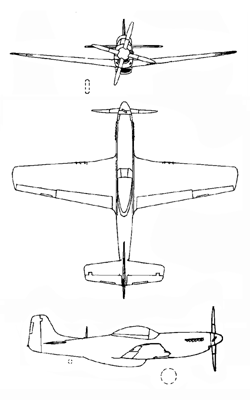 P-51 Mustang 3view (generic)
DESCRIPTION: Single seat, long range fighter. All metal stressed-skin construction. POWER PLANT: One 1,490 hp Packard Merlin V-1650-7. DIMENSIONS: Span, 37 ft: length, 32 ft 3 ins; height 8 ft 8 ins. WEIGHTS: Empty, 7,000 lb; loaded, 11,600 lb. PERFORMANCE: Max speed, 437 mph at 25,000 ft. Climb, 13 mins/30,000 ft. Service ceiling 41,900 ft. Range, 950 miles normal/1,700 miles max. ARMAMENT: Six 0.50 calibre guns; two 1,000 lb. bombs or up to 10 rockets. "The Squadrons Mustangs were used extensively in the close support and interdiction roles, striking Communist targets both south and north of the 38th parallel. In April 1951 77 Squadron was re-equipped with Meteor jet fighters. The Australians gained their first confirmed MiG "kill" on 1 December when twelve Meteors were engaged by over fifty MiG 15s over Pyongyang. For the destruction of one MiG the squadron lost three Meteors with a further two damaged. This encounter highlighted the MiG's superiority in aerial combat, and as a result, the Meteor's were confined to ground attack operations. In this role, the Meteors took a considerable toll on North Korean and Chinese ground forces, however, the Squadron suffered heavily at the hands of the MiG's and anti-aircraft units. By the end of hostilities in July 1953, 76 squadron had lost thirty eight aircrew, with another seven captured by the enemy."
Mustangs in Korea The F-82 was not the only Mustang to serve in Korea. The old P-51D, by then redesignated F-51D, fought with distinction, back in the original Mustang assignment of "mudfighter". After the end of WW II, piston-engine fighters were rapidly phased out of front-line service in favor of new jet fighters, such as the P-80 Shooting Star. Keith Meggs comments: The F-82 'Twin Mustang' was only a minor player. It was used as a nightfighter on a 'one-off' basis flying from USAF bases in Japan . The P-51 was the most numerous aircraft in use overall The USAAF retained a few squadrons of P-51Hs, but the older P-51Ds were passed on to the Air National Guard (ANG). As late as 1952, the ANG would still have 68 squadrons flying the Mustang, though the last of them would be gone in 1957. Most of the remaining Mustangs were either sold to foreign operators or scrapped. In the early summer of 1950, the USAF had three fighter groups operating in Japan that had converted from the F-51D to the F-80, and the old F-51Ds were sitting in storage, waiting to be scrapped. When the war broke out on 25 June, the USAF realized that the F-51Ds were what was needed to help stem the North Korean offensive. The North Koreans, as noted, had no advanced aircraft, and the F-51D had better endurance and warload than the F-80, though some Air Force officers worried, with good reason, about the Mustang's traditional vulnerability to ground fire. The P-51D could also operate more effectively than jets from primitive airfields. The three fighter groups traded their F-80s back in for their old F-51Ds and were thrown into the battle. The USAF also withdrew 145 F-51Ds from ANG units and rushed them to Japan on the carrier USS BOXER, which arrived in Tokyo on 23 July 1950. Two squadrons were equipped with the new arrivals, and were quickly flying dozens of sorties a day from rough airstrips behind the front lines in Korea. A squadron each of Mustangs was provided by Australia and South Africa. F-51Ds were also supplied to the South Koreans. The Mustangs struck at enemy columns with machine guns, bombs, HVARs, and napalm.
Keith Meggs comments: the use of the term HVARs or High Velocity Aircraft Rockets should simply read 'rockets'. I believe that 77 Sqdn would have initially been using rockets supplied from Australia, distinguished by the large 'fat' nose where the HVARs were more tubular with a pointed nose. We certainly used them solely from American suppliers in my time there from late December 1950
The notorious vulnerability of the Mustang's cooling system was a particular problem. Some thought was in fact given to fielding a squadron of Republic F-47N Thunderbolts, which were better close-support aircraft, but the aircraft were simply not available. By the fall (Autumn) of 1950, the North Koreans were on the run, and the Americans and their allies were pursuing them into North Korea. Mustangs ranged freely with little air opposition. They scored five kills during this time, their only air combat victories of the war. In early November, Mustangs began to encounter Chinese MiG-15s, and it was only due to the skill of the Mustang pilots and the inexperience of the enemy that the F-51Ds were able to survive. By the time cold weather set in, Chinese forces were pouring into North Korea, driving the Americans and their allies south in a fast retreat that stopped at the South Korean border. The front lines stabilized there and a static war of attrition followed. With the USAF countering the Soviet MiG-15s with the North American F-86, the air combat environment became increasingly too dangerous for piston engine fighters like the F-51D. Most units equipped with the Mustang converted to jets, and by the end of the war in July 1953, only one USAF squadron and some South Korean units were operating the Mustang. A total of 194 F-51Ds were lost in the war. 172 were destroyed by ground fire, 10 were shot down by enemy aircraft, and 12 were lost to unreported causes. This is said to be the highest loss ratio of any aircraft operated by the Americans and their allies in the Korean War.
Mustangs in 'Foreign' Service "The Australians, [...] actually built Mustangs of their own, and in fact had more of them than they knew what to do with at one time, 77 Sqdn was to put the Mustang to good use in Korea. The New Zealanders ordered 170 Mustangs before the end of WW II, but by the end of hostilities, only 30 had been delivered. These would operate into the 1950s"
The following images are initially posted no particular order with date, location and citation details tba. These are still being researched with the help of ex Mustang, Meteor, Sabre and Vampire pilot Keith Meggs, Tony Lyons and others (Ed.)
Type: CA-18, Serial #: 44-14777a, Registry: N51AB, Owner: Brian Adams, Base: Hollister CA, Status: Flying, History / Previous Identities: 1947: RAAF, 1961: VH-BOW , 1968: rebuilt in USA, adopted 44-14777, N51AB, 1990: (Norman Lewis) Miss Escort, 414777, later Flying Dutchman, 1999: (Dr. Brian Adams) Hollister, Ca. Photo Credits : Curtis Fowles, Mark Kallio
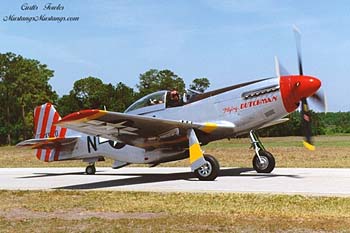 CA-18 Mustang (A68-100), HL-N 'Flying Dutchman' http://www.p-51mustangs-aliveandwell.com/aircraft/p51/A68-100.shtml
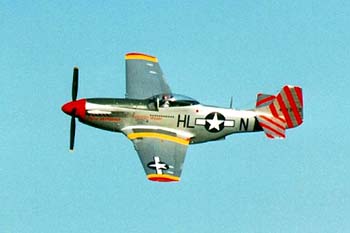 CA-18 Mustang (A68-100), HL-N 'Flying Dutchman' http://www.p-51mustangs-aliveandwell.com/aircraft/p51/A68-100.shtml
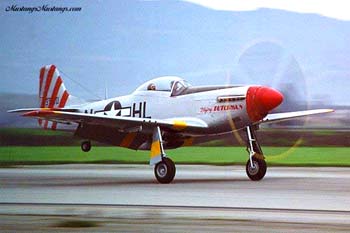 CA-18 Mustang (A68-100), HL-N 'Flying Dutchman' http://www.p-51mustangs-aliveandwell.com/aircraft/p51/A68-100.shtml
CA-18 Mk.21 Mustang Mustang (A68-104) Type : CA-18 (construction no.1329), Serial # : A68-104, Registry : VH-BOB, Owner : Bob Eastgate, Base : Australia, Status: Flying, History / Previous Identities: November 1947 to April 1958, RAAF, 1970: VH-BOB (Robert L. (Bob) Eastgate) also... Following RAAF service, this particular aircraft, A68-104, was purchased by A.J. Oates from the Department of Supply in 1960 but saw little flying until operated, unregistered, from Barham on the NSW/VIC border between 1964 and 1966. During 1966 the aircraft was resold and flown to a property near Jerilderie where, after a short period, it forced landed and suffered damage to the starboard wing. The aircraft was then purchased by Mr W. Eastgate of Melbourne and flown to Moorabbin for restoration. Registered as VH-BOB, this is the only Australian Mustang licenced for commercial operations. The rear fuselarge 71 imp gal fuel tank was removed, allowing a rear seat to be installed for the carriage of a single passenger. Passenger flights can be arranged in this famous fighter aircraft. VH-BOB is based at Point Cook, the home of NASMA and the RAAF Museum, and can be seen flying on most weekends. It is a frequent and popular performer at Point Cook open days and at air shows around Australia. Notes taken from p-51d_a68-104.txt a file relating to WW2 flight simulation programming available from Marius Helmholz, Hannover, Germany
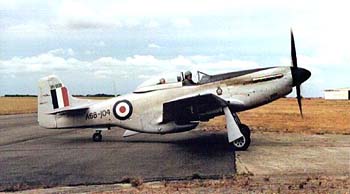 CA-18 Mk.21 Mustang Mustang (A68-104) as seen at Richmond, New South Wales, 1991 http://www.p-51mustangs-aliveandwell.com/aircraft/p51/A68-104.shtml
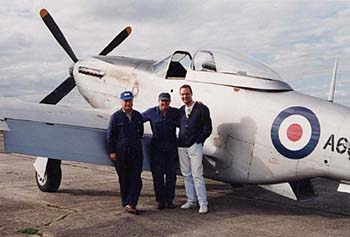 CA-18 Mk.21 Mustang (A68-104) VH-BOB, c.1998 Chief Mechanic for '104, Andy Mielnik (sometimes misspelt as Milnick), (L) the owner of '104 Bob Eastgate and Tony Lyons (R) also available as a 1000 pixel image photo : Anthony (Tony) Lyons
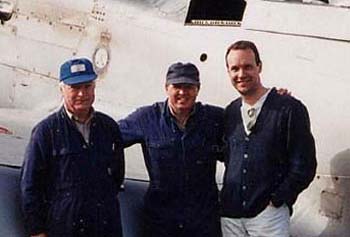 Andy Mielnik, Bob Eastgate and Tony Lyons, c.1998 photo : Anthony (Tony) Lyons
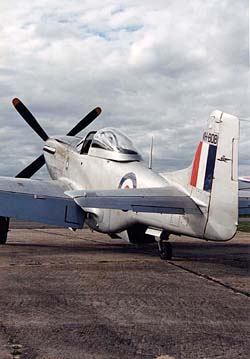 CA-18 Mk.21 Mustang (A68-104) VH-BOB, c.1998 photo : Anthony (Tony) Lyons
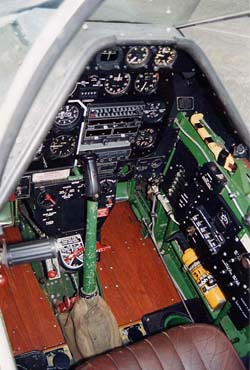 CA-18 Mk.21 Mustang (A68-104) VH-BOB (Cockpit), c.1998 photo : Anthony (Tony) Lyons
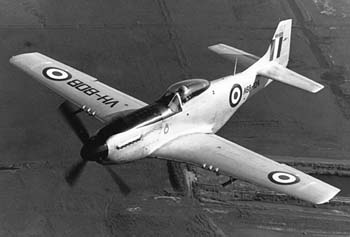 CA-18 Mk.21 Mustang (A68-104) VH-BOB also available as a 1000 pixel image Photo courtesy Tony Lyons
CA-18 Mustang (A68-118) Type : CA-18, Serial # : A68-118, Registry : VH-AGJ, Owner : Jeff Trappett, Base : Australia, Status : Flying, History / Previous Identities : 1948: RAAF, 1959: VH-WAS (Joe Palmer), 1979: VH-AGJ restored (Jeff Trappett)
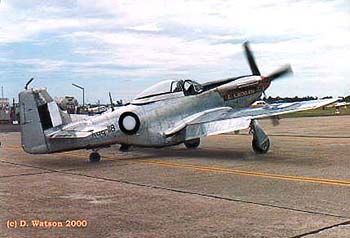 CA-18 Mustang (A68-118) Photo; Darryl Watson http://www.chariot.net.au/~theburfs/mustangpage3.html
CA-18 Mustang (A68-192) 'Big Beautiful Doll' Type : CA-18, Serial # : A68-192, Registry : G-HAEC, Owner : Rob Davies, Base : UK, Status : Flying, History / Previous Identities: 1951: RAAF (8 March, 1951: Commonwealth Aircraft Corporation), 1958: VH-FCB (F.C. Braund), 1961: (Jack McDonald), 1969: PI-C651 Philippines (Prontino Inc.), 1973: crashed on landing, rebuilt using 44-72917, 1981: VR-HIU (Hong Kong) 1985: rebuilt "CV H" , shipped to UK, 1985: G-HAEC, "Ding Hao", "Missy Wong from Hong Kong", "RAAF A68-192" Photo Credits : Peter Evans, Ben Rogers, Paul Nann
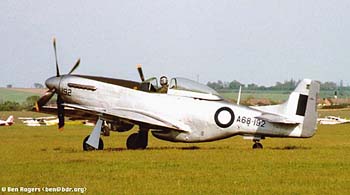 CA-18 Mustang (A68-192) 'Big Beautiful Doll' also available as a 1000 pixel image http://www.p-51mustangs-aliveandwell.com/aircraft/p51/A68-192.shtml
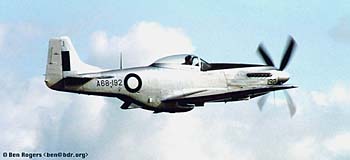 CA-18 Mustang (A68-192) 'Big Beautiful Doll' also available as a 1000 pixel image http://www.p-51mustangs-aliveandwell.com/aircraft/p51/A68-192.shtml
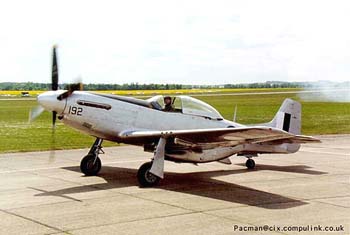 CA-18 Mustang (A68-192) 'Big Beautiful Doll' also available as a 750 pixel image http://www.airwar.ru/photo.html
 There are more photographs of Mustangs in our story of the Commonwealth Aircraft Factory There are more photographs of Mustangs in our story of the Commonwealth Aircraft FactoryPlease note that it may take a short while to load all the images
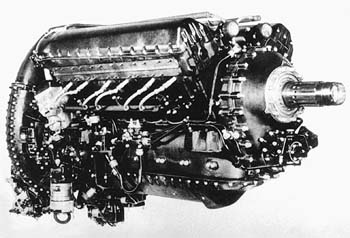 Packard-built Merlin Engine imported from Detroit, USA also available as a 1000 pixel image Photo courtesy Tony Lyons
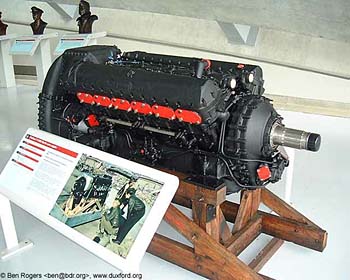 Packard-built Merlin Engine imported from Detroit, USA also available as a 750 pixel image http://www.duxford.org/exhibits/hangar1/exhibits/
Merlin Packard Engine http://www.13thtas.com/Merlin.html The V-1650 liquid-cooled engine was the U.S. version of the famous British Rolls-Royce "Merlin" engine which powered the "Spitfire" and "Hurricane" fighters during the Battle of Britain in 1940. In Sept. 1940, the Packard Co. agreed to build the Merlin engine for both the American and the British Governments, and adapted it for American mass-production methods. The first two Packard-built Merlins to be completed were demonstrated on test stands at a special ceremony at the Packard plant in Detroit on August 2, 1941. Full production began in 1942 and by the end of World War II, more than 16,000 Merlins had been produced in the U.S.A. The Army Air Forces used the engine almost exclusively in the famed P-51 "Mustang", for it provided greatly improved high-altitude performance over the Allison V-1710 engine used in earlier series of the airplane. The V-1650 Merlin also replaced the V-1710 in the "F" series of the P-40. The British also used Packard-built Merlins during the last three years of the war in their "Spitfire", "Mosquito", and "Lancaster" airplanes. SPECIFICATIONS
Model: V-1650-7
The Times, June 14 1999 Ronald Harker, OBE, AE, wartime test pilot, died in Taupo, New Zealand, on May 30 aged 90. He was born on March 4, 1909. Ronnie Harker has his place in the history of aviation for the role he played in the evolution of the Mustang fighter into one of the great warplanes of its era. The P51 Mustang had originally been designed and built by North American Aviation in 1940 in answer to a request by the British Purchasing Commission to produce a fighter for the RAF which would be an advance on the Spitfire. The result, produced in the incredibly short time of 117 days, had many pleasing qualities, but its Allison V1710 engine gave it poor performance at high altitude, and its range was short. The aircraft entered service with the RAF in 1941, but because its performance did not challenge that of the latest marks of Spitfire it was relegated to Army co-operation and photographic work. However, Ronnie Harker, Rolls-Royce's senior liaison test pilot, was offered the opportunity to test the Mustang by the RAF. He liked the aircraft's handling qualities but not its engine, which was too low-powered to exploit the aircraft's advanced aerodynamic features. He was convinced that the plane would be another animal entirely if fitted with the Rolls-Royce Merlin, powerplant of the Spitfire. Harker pressed strongly for the American engine to be replaced by the Merlin and after a good deal of official reluctance, largely from the Air Ministry, he got his way. The result was a transformation. The Mustang's top speed leapt from 390mph to 440mph and the range from 450 miles to as much as 2,000 with various configurations of drop tanks. A great escort fighter had been born and the Americans, realising that the Rolls-Royce solution provided the answer to the horrific losses the USAAF's daylight bombing raids had been suffering in the early part of 1943, put the fighter into mass production, using Packard and Continental-built versions of the Rolls-Royce engine. Very soon the Flying Fortresses of the US 8th Army Air Force were able to rove as far as Berlin, escorted all the way by Mustangs which began to take a toll of the Luftwaffe's fighters. When Goering saw the Mustangs escorting the American air armadas over the capital of the Reich he is said to have realised that Germany had lost the war. Such was the momentousness of one man's determination. Ever afterwards Harker was known as "the man who put the Merlin in the Mustang". Ronald Ward Harker was born at Tynemouth, where his father was chief medical officer for the Tyne ports. He was educated at Shrewsbury School and joined Rolls-Royce in 1925 as an engineering apprentice. In 1927 a visit to the Hendon Air Display gave him the impulse to fly. He joined Newcastle flying club in 1927. He finished his apprenticeship in 1929, but by that time the Depression was biting and there was no job for him at Rolls-Royce. With parental support he kept up his flying at the Lympne flying club in Kent, and in 1934 was invited back to Rolls-Royce on the aero-engine side. When Rolls-Royce formed its first test flight he became its first test pilot and was soon evaluating various types of RAF aircraft. He also joined No 504 City of Nottingham Squadron, Royal Auxiliary Air Force, based at Hucknall, where Rolls-Royce was soon to move its test flying. When war came in 1939 he joined his squadron on a full-time basis, but in the spring of 1940, with the squadron ordered to France, he was ordered back to Rolls-Royce to resume test flying at Hucknall, liaising closely with the RAF. Harker was at Hucknall when, in April 1942, he received a telephone call from the CO of the RAF's Air Fighting Development Unit at Duxford, to tell him that they had acquired an Allison-engined Mustang and would he like to evaluate it? Having spent 30 minutes throwing the aircraft round the sky he reported that it closely resembled the Messerschmitt 109F, but with a Merlin 61 engine ought to prove much faster than that aircraft and the Spitfire V. The Air Ministry, however, wanted to put all the available Merlin 61s into the new Spitfire IX to combat the threat of the latest German fighter, the Focke Wulf 190, which was proving vastly superior to the Spitfire V in combat. There was therefore a good deal of concerted scepticism about Harker's observations. But he persisted and the first Merlin-engined Mustang flew in October 1942, giving the radical improvements in performance that he had predicted. News of the Merlin Mustang's performance spread like wildfire and was greeted as manna from heaven in Washington. Indeed, the Americans were the chief beneficiaries of Harker's initiative, since the new escort fighter enabled the USAAF to resume daylight bombing raids which had been discontinued, since the "invulnerable" B17 Flying Fortress had proved incapable of defending itself against the Luftwaffe's fighters. Throughout the war Harker was involved in a variety of other projects for improving the performance of RAF aircraft. Improvements in superchargers increased the speed of the Spitfire; Merlins were put into the Whitley bomber; and - the greatest bomber success of all - the disastrous Vulture-engined Avro Manchester became the superlative Merlin-engined Lancaster. But the Mustang remains his supreme achievement. By the end of the war 15,582 of the aircraft had been built. Harker was appointed OBE and given the Air Efficiency Award (AE) for his wartime work. After the war Harker continued his liaison work with the RAF, testing new types. In 1974 he moved to London as Rolls-Royce's aero-export manager and from 1957 as the company's military adviser. He retired from the firm in 1971 when it went bankrupt over the financial problems caused by the escalating cost of the RB211 engine for the Lockheed TriStar. Over the years he had spent an increasing amount of time in New Zealand, pursuing his passion for fishing - and flying - and he finally settled there with his second wife in 1993. He had his last flight in a Mustang in New Zealand in 1997 at the age of 88. Ronnie Harker was twice married, first to Marjorie Turner, who died in 1979. His second marriage was to Elizabeth Dove, who survives him with the two daughters of his first marriage.
RONNIE HARKER, who has died aged 90, made a signal contribution as a test pilot to Allied victory in the air during the Second World War.Ronnie Harker was born in the year Bleriot crossed the Channel from France to England, and was a seasoned pilot when the Luftwaffe came in the same direction in 1940. Though he did not see combat, his association with the Merlin aero-engine put him in the front line of preparing Spitfire and Hurricane squadrons to meet the challenge, and later in devising the Merlin-powered Mustang fighter which took the air war back to the heart of Germany.As senior test pilot for Rolls-Royce, the company that manufactured the Merlin, Harker flew between combat squadrons during the Battle of Britain, organising a flow of spare parts to keep the fighters flying. At the same time he stood ready to defend the company's experimental aerodrome at Hucknall near Nottingham from German bombers.In the technical race with Germany that followed the Battle of Britain, Harker test-piloted the Merlin 60 series engine. During the test programme a colleague was killed, but at last Harker overcame the carburetted powerplant's habit of cutting out in tight turns under negative G. The new engine powered the Spitfire IX, greatly improving the fighter's performance. But Harker won his place in the history of aviation as "the man who put the Merlin in the Mustang". He was the first to spot the potential of the otherwise mediocre fighter that had been ordered for the RAF from North American Aviation just after the fall of France.He tested an early production Mustang on April 30 1942 at the Air Fighting Development Unit at Duxford, and reported approvingly of its fuel load - three times that of a Spitfire - and its heavy armament. Its airframe, he found, was aerodynamically advanced and manoeuvreable up to 20,000 feet, but its Allison engine was underpowered for high altitude combat.Harker knew the solution, and asked colleagues to see how the aircraft would perform with a Merlin 61. This engine was at the time being manufactured under high priority for the Spitfire IX - a fighter needed to counter the threat of the latest German Focke-Wulf 190 fighter. At first, Rolls-Royce executives were reluctant, but Harker persuaded them. Sir Wilfrid Freeman at the Air Ministry was brought round, and six weeks later the first Merlin-Mustang was test flown from Hucknall. Thus the greatest piston-engined fighter of the war was born. Harker got a pay rise of a pound a week.The Merlin-Mustang was ordered for the US Army Air Force as the P-51. Mass produced in the United States with Merlin engines and licence-built by Packard, more than 15,000 were manufactured. Drop tanks added strategic range, and from 1944 Mustangs escorted US 8th Air Force bombers with enough fuel to engage defending fighters as far as Berlin. After D-Day, Mustangs ranged over north-west Europe shooting up German transport.Ronald Ward Harker was born on March 4 1909 at Tynemouth, the son of the chief medical officer for Tyneside. He joined Rolls-Royce aged 16 from Shrewsbury School as an apprentice, enthusiastically taking up flying after visiting the 1927 Hendon Air Pageant. After Rolls was hit by the Depression he was laid off, but with the help of his father he continued to fly as a club pilot. Harker rejoined Rolls in 1934, moving to Hucknall as its first test pilot, proving Goshawk, Kestrel and Merlin engines in a range of types. In 1938 he was instrumental in settling into service the first operational Hawker Hurricane squadron, No 111, at Northolt.On the outbreak of war, he joined No 504, County of Nottingham Squadron, serving as a flight lieutenant. But when his squadron was ordered to France in March 1940, Harker returned to Rolls.As well as the Mustang, Harker worked on re-engineering RAF bombers for the liquid-cooled, in-line Merlin. He also helped to transform the abysmal twin Vulture-powered Avro Manchester into the Lancaster, the best heavy bomber of the war. For his wartime work Harker was appointed OBE and given the Air Efficiency award.Harker stayed with Rolls after the war, becoming a sales executive in 1947 and military aviation adviser 10 years later. On his advice the Royal Navy ordered the US F-4 Phantom fighter with Rolls-Royce Speys.He retired, reluctantly, in 1971 when the company went into receivership, crippled by the development costs of the RB211 engine. Harker became an independent aviation consultant, and made a new home in New Zealand. There in 1997, aged 88, he took the controls of a Mustang at an air display.Ronald Harker married, first, Marjorie Turner, who died in 1979, and secondly Elizabeth Dove, who survives him, with two daughters of his first marriage.
The Times of London obituary was reprinted in The Dominion of Wellington, New Zealand of 18 June 1999, under the heading "The Man who put the Merlin in the Mustang", with a photo of him taken after a flight in a Mustang in New Zealand in 1997. This is probably at the "Warbirds over Wanaka" display near Dunedin. A death notice in the New Zealand Herald (Auckland) of 3rd June 1999 said that he had died at Taupo on May 30, 1999 and that a private family service had been held at Taupo the previous day. (Taupo in the middle of the North Island of New Zealand has good trout fishing, presumably why he settled there). The OBE refered to is an award/medal not an appointment, the Order of the British Empire.
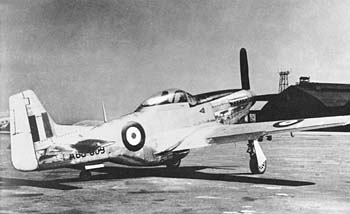
CAC Mustang Photo courtesy Tony Lyons
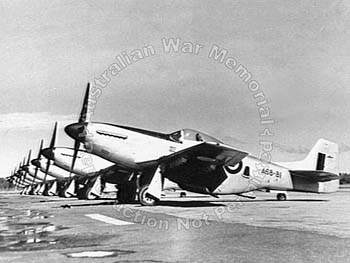 CAC Mustangs of 4 Squadron RAAF, Canberra, ACT, October 3, 1947 Australian War Memorial Negative Number: P0161/26/25
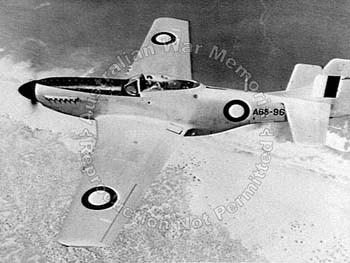 CAC Mustang (A68-96) of No. 78 (Fighter) Wing, RAAF
The aircraft, en route Pearce, W.A. to Williamtown, N.S.W. following Australia Day activities in West Australia, January 1948, is being flown by Wing Commander R. C. (Dick) Creswell. The three other Mustangs were flown by Squadron Leader J. Kinninmont DFC, Flight Lieutenant R. H. Glossop DFC and Flight Lieutenant R. Grace. The photo was taken from GAF Lincoln (A73-10) of No 82 Bomber Wing RAAF, Amberley, Qld. piloted by Wing Commander K. R. Parsons DFC, AFC and which provided escort to the Mustangs. Donor : R. C (Dick) Creswell Australian War Memorial Negative Number: P1254/162/024
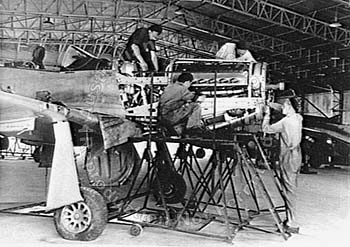 CAC Mustang of No 2 Operational Training Unit RAAF, Williamtown, N.S.W., Feb. 24, 1948 Australian War Memorial, Negative Number: P1254/162/067. Donor : R. C (Dick) Creswell
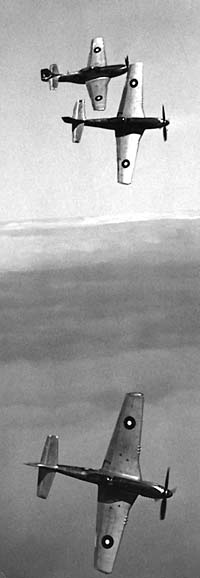 CAC Mustangs 'peeling off' in formation Argus (Melbourne, Vic.), State Library of Victoria, Library Record Number: 1151240, Accession Number: H98.100/4316
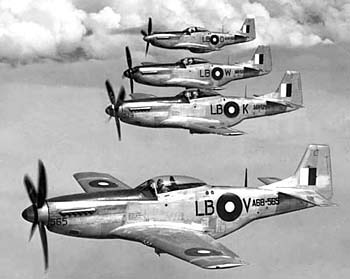 CAC Mustangs in Formation Argus (Melbourne, Vic.), State Library of Victoria, Library Record Number: 1151268, Accession Number: H98.100/4317
"Flying from Townsville, Qld. 1945-07-27. Four P-51 Mustang aircraft of No. 84 Squadron RAAF, newest fighter to be flown by Australians in this theatre of war, flying in echelon right, up formation. Pilots and aircraft, front to rear: 290898 Squadron Leader J. A. Cox* of Mt Lawley, WA, in aircraft A68-565, coded LB-V a North American P-51K-10-NT; 404355 Flight Lieutenant R. G. Riddel of Galloway Hill, Qld, in aircraft A68-529 coded LB-K; 402530 Flight Lieutenant D. N. McQueen of Grafton, NSW, in aircraft A68-526 coded LB-W; 411111 Flight Lieutenant S. E. Armstrong of Charleville, Qld, in aircraft A68-523 coded LB-0". *on another image (Australian War Memorial Negative Number: NEA0693) stated to be "290787 Squadron Leader J. A. Cox"
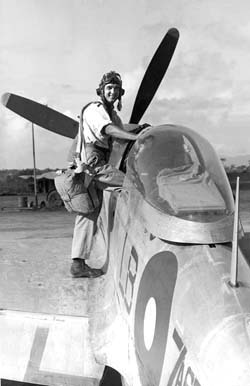 Flying Officer D. V. Terry Argus (Melbourne, Vic.), State Library of Victoria, Library Record Number: 1190845, Accession Number: H98.104/3880
"Townsville, Qld. 1945-07-27. North American P-51K-10-NT Mustang fighter aircraft A68-557 coded LB-Z, of No. 84 Squadron RAAF, based at Ross River airfield. Pilot, 418588 Flying Officer D. V. Terry of Elwood, Vic, is boarding with parachute."
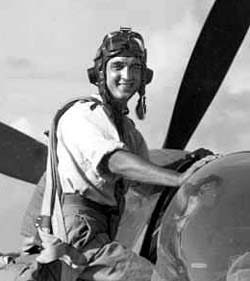 Flying Officer D. V. Terry Argus (Melbourne, Vic.), State Library of Victoria, Library Record Number: 1190845, Accession Number: H98.104/3880 NB: ditto full version of the image above
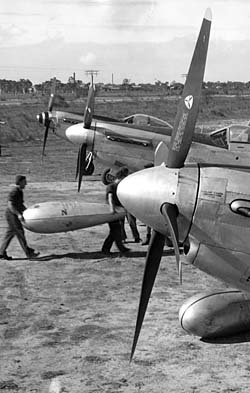 Mustang Image, (undated) Argus (Melbourne, Vic.), State Library of Victoria, Library Record Number: 1190845, Accession Number: H98.104/3879
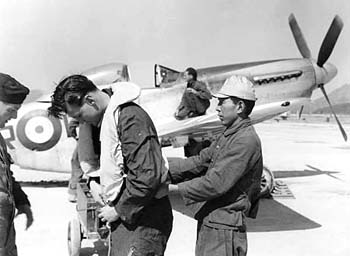 British Commonwealth Occupation Force (BCOF) airmen, Bofu, Japan c.1947/48 Argus (Melbourne, Vic.), State Library of Victoria, Library Record Number: 1206441, Accession Number: H98.100/395
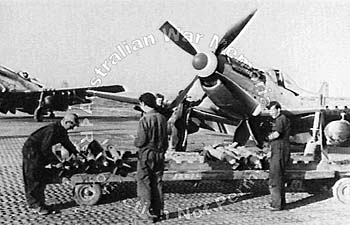 Arming a 77 Squadron Mustang, Taegu, South Korea, October 1950 Australian War Memorial Negative Number: P0337/13/09
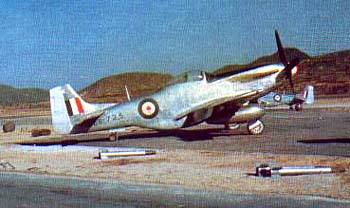 small, undated image in colour of 'a Mustang in Korea' Futher research needed on this one. Reasonably rare if indeed from this period
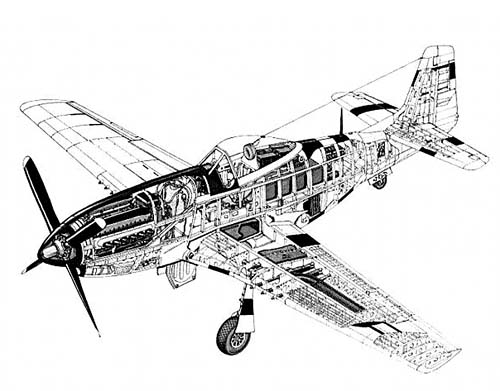 Mustang construction diagram also available as a 750 pixel image citation tba
other essays...
ADF Aircraft Serial Numbers : A68 CAC CA-17/CA-18 Mustang & North American P-51D/K Mustang
P-51D Mustang
North American P-51D/K Mustang
The Mustang P-51D/K In 'Foreign' Service
Fighters in Transition
WW2 Warbirds: the North American P-51 Mustang
North American P-51 Mustang This comprehensive essay is cached on this site for backup purposes only should the prime site fail. Further Reading Bartlett, Norman, With the Australians in Korea. Canberra: Australian War Memorial, 1954 Donselar, Annette, (Ed.), compiled by Wayne Brown, Andrew Cork, Colin Faggo Swift To Destroy - An illustrated History of 77 Squadron RAAF, 1942 - 1986 ; Norman Morris Printers ; Newcastle, Australia, 1986 Hill, Brian L., Wirraway to Hornet : a history of the Commonwealth Aircraft Corporation Pty Ltd, 1936 to 1985; Bulleen, Vic. : Southern Cross Publications, 1998 Odgers, George. Across the Parallel: The Australian 77th Squadron with the United States Air Force in the Korean War. Melbourne: William Heinemann Ltd, 1953 Pentland Geoffrey, Malone Peter : Aircraft of the RAAF 1921-71 - Jubilee Issue ; Melbourne: Kookaburra Technical Publications, 1971 Stephens, Alan. Going Solo: The Royal Australian Air Force 1946-1971. Canberra: AGPG Press, 1995 Wilson, David, Lion over Korea : 77 Fighter squadron, RAAF, 1950-53. Belconnen, A.C.T. : Banner Books, 1994
|
© Copyright 1999-2002 CTIE - All Rights Reserved - Caution |